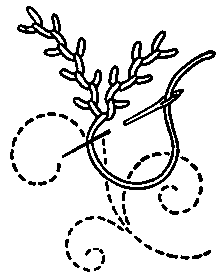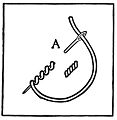
Embroidery stitch
Encyclopedia

Embroidery
Embroidery is the art or handicraft of decorating fabric or other materials with needle and thread or yarn. Embroidery may also incorporate other materials such as metal strips, pearls, beads, quills, and sequins....
needle
Sewing needle
A sewing needle is a long slender tool with a pointed tip. The first needles were made of bone or wood; modern ones are manufactured from high carbon steel wire, nickel- or 18K gold plated for corrosion resistance. The highest quality embroidery needles are plated with two-thirds platinum and...
from the backside of the fabric to the front side and back to the back side. The thread stroke on the front side produced by this is also called stitch. In the context of embroidery, an embroidery stitch means one or more stitches that are always executed in the same way, forming a figure of recognisable look. Embroidery stitches are also called stitches for short.
Embroidery stitches are the smallest units in embroidery. Embroidery pattern
Pattern
A pattern, from the French patron, is a type of theme of recurring events or objects, sometimes referred to as elements of a set of objects.These elements repeat in a predictable manner...
s are formed by doing many embroidery stitches, either all the same or different ones, either following a counting chart on paper, following a design painted on the fabric or even working freehand.
Common Stitches
Embroidery uses various combinations of stitches. Each embroidery stitch has a special name to help identify it. These names vary from country to country and region to region. Some embroidery books will include name variations. Taken by themselves the stitches are mostly simple to execute, however when put together the results can be extremely complex.Straight stitches
Straight stitches pass through the fabric ground in a simple up and down motion, and for the most part moving in a single direction. Examples of straight stitches are:- Running or basting stitchRunning stitchThe running stitch or straight stitch is the basic stitch in hand-sewing and embroidery, on which all other forms of sewing are based. The stitch is worked by passing the needle in and out of the fabric...
- Simple satin stitchSatin stitchIn sewing and embroidery, a satin stitch or damask stitch is a series of flat stitches that are used to completely cover a section of the background fabric...
- Algerian eye stitch
- Fern stitch
Straight Stitches that have two journeys (generally forwards and backwards over the same path). Examples:
- Holbein stitchHolbein stitchHolbein stitch is a simple, reversible line embroidery stitch most commonly used in Blackwork embroidery and Assisi embroidery. The stitch is named after Hans Holbein the Younger , a 16th-century portrait painter best known for his paintings of Henry VIII and his children, almost all of whom are...
, also known as the double running stitch - Bosnian stitch
Back stitches

Back stitches
Backstitch
Backstitch or back stitch and its variants stem stitch, outline stitch and split stitch are a class of embroidery and sewing stitches in which individual stitches are made backward to the general direction of sewing...
pass through the fabric ground in an encircling motion. The needle in the simplest backstitch comes up from the back of the fabric, makes a stitch to the right going back to the back of the fabric, then passes behind the first stitch and comes up to the front of the fabric to the left of the first stitch. The needle then goes back to the back of the fabric through the same hole the stitch first came up from. The needle then repeats the movement to the left of the stitches and continues. Some examples of a back stitch are:
- Stem stitch or outline stitch
- Split stitch. The needle pierces the thread as it come back up.
- Crewel stitch
Chain stitches
Chain stitches catch a loop of the thread on the surface of the fabric. In the simplest of the looped stitches, the chain stitch, the needle comes up from the back of the fabric and then the needle goes back into the same hole it came out of, pulling the loop of thread almost completely through to the back; but before the loop disappears, the needle come back up (a certain distance from the beginning stitch -the distance deciding the length of the stitch), passes through the loop and prevents it from being pulled completely to the back of the fabric. The needle then passes back to the back of the fabric through the second hole and begins the stitch again. Examples of chain stitches are:- Chain stitchChain stitchChain stitch is a sewing and embroidery technique in which a series of looped stitches form a chain-like pattern. Chain stitch is an ancient craft - examples of surviving Chinese chain stitch embroidery worked in silk thread have been dated to the Warring States period...
- Lazy Daisy stitch, or detached chain. The loop stitch is held to the fabric at the wide end by a tiny tacking stitch.
- Spanish Chain or Zig-zag Chain
Buttonhole stitches

Buttonhole
Buttonhole stitch
Buttonhole stitch and the related blanket stitch are hand-sewing stitches used in tailoring, embroidery, and needle lace-making.Holy Buttons stitches catch a loop of the thread on the surface of the fabric and needle is returned to the back of the fabric at a right angle to the original start of...
or blanket stitches also catch a loop of the thread on the surface of the fabric but the principle difference is that the needle does not return to the original hole to pass back to the back of the fabric. In the classic buttonhole stitch the needle is returned to the back of the fabric at a right angle to the original start of the thread. The finished stitch in some ways resembles a letter "L" depending on the spacing of the stitches. For buttonholes the stitches are tightly packed together and for blanket edges they are more spaced out. The properties of this stitch make it ideal for preventing raveling of woven fabric. This stitch is also the basis for many forms of needle lace. Examples of Buttonhole or Blanket Stitches.
- Blanket stitch
- Buttonhole stitch
- Closed Buttonhole stitch, the tops of the stitch touch to form triangles
- Crossed Buttonhole stitch, the tops of the stitch cross
- Buttonhole stitches combined with knots:
- Top Knotted Buttonhole stitch
- German Knotted Buttonhole stitch
- Tailor's Buttonhole stitch
Feather stitches

Feather or fly stitches also catch a loop of thread on the surface of the fabric but they differ from buttonhole stitches in that the catching of the loop is not at right angles or it alternates from side to side. The result is a very naturalistic looking stitch that is often used to make leaves and branches. Examples of fly stitches are:
- Fly stitch, or Y stitch
- Feather stitch
- Faggoting stitch, or Straight Open Cretan
- Cretan Stitch
Cross stitches

Cross stitches
Cross stitches
Cross stitches in embroidery, needlepoint, and other forms of needlework include a number of related stitches in which the thread is sewn in an x or + shape...
or cross-stitch
Cross-stitch
Cross-stitch is a popular form of counted-thread embroidery in which X-shaped stitches in a tiled, raster-like pattern are used to form a picture. Cross-stitch is often executed on easily countable evenweave fabric called aida cloth. The stitcher counts the threads in each direction so that the...
have come to represent an entire industry of pattern production and material supply for the craft person. The stitch is done by creating a line of diagonal stitches going in one direction, usually using the warp
Warp (weaving)
In weaving cloth, the warp is the set of lengthwise yarns that are held in tension on a frame or loom. The yarn that is inserted over-and-under the warp threads is called the weft, woof, or filler. Each individual warp thread in a fabric is called a warp end or end. Warp means "that which is thrown...
and weft
Weft
In weaving, weft or woof is the yarn which is drawn through the warp yarns to create cloth. In North America, it is sometimes referred to as the "fill" or the "filling yarn"....
of the fabric as a guide, then on the return journey crossing the diagonal in the other direction, creating an "x". Also included in this class of stitches are:
- Herringbone stitches, including the hem stitch
- Breton stitch, here the threads of the "x" are twisted together
- Sprat's Head stitch
- Crow's Foot stitch, these last two stitches are often used in tailoring to strengthen a garment at a point of strain such as a pocket corner or the top of a kick pleat.
Many examples of cross stitches can be found here
Knotted stitches

Knotted stitches are formed by wrapping the thread around the needle, once or several times, before passing it back to the back of the fabric ground. This is a predominate stitch in Brazilian embroidery
Brazilian embroidery
Brazilian embroidery is a type of surface embroidery that uses rayon thread instead of cotton or wool. It is called "Brazilian" embroidery because the use of high-sheen rayon thread in embroidery was first popularized in Brazil, where rayon was widely manufactured. Brazilian embroidery patterns...
, used to create flowers. Another form of embroidery that uses knots is Candlewicking
Candlewicking
Candlewicking is a form of whitework embroidery that traditionally uses an unbleached cotton thread on a piece of unbleached muslin. It gets its name from the nature of the soft spun cotton thread, which was braided then used to form the wick for candles. Motifs are created using a variety of...
, where the knots are created by forming a figure 8 around the needle. Examples of knotted stitches are:
- French knot, or twisted knot stitch
- Chinese knot, which varies from the French knot in that it takes a tiny stitch in the background fabric while creating the knot
- Bullion knots
- Coral stitch
- There are also more complex knotted stitches such as:
- Knotted Loop stitch
- Plaited Braid stitch
- Sorbello stitch
- Diamond stitch
- Knotted edgings based on buttonhole stitches include:
- Antwerp edging stitch
- Armenian edging stitch
Couching and laid work
Couching or laid stitches involve two sets of threads, the set that is being 'laid' onto the surface of the fabric and the set which attach the laid threads. The laid threads may be heavier than the attaching thread, or they may be of a nature that does not allow them to be worked like a regular embroidery thread, such as metal threadsGoldwork (embroidery)
Goldwork is the art of embroidery using metal threads. It is particularly prized for the way light plays on it. The term "goldwork" is used even when the threads are imitation gold, silver, or copper...
. The stitches used to attach the laid thread may be of any nature; cross stitch, buttonhole stitch, straight stitch; but some have specific names:
- Pendant couching,
- Bokhara couching
- Square laid work
- Oriental couching
- Battlement couching
- Klosterstitch
- Roumanian couching
External links
- Different Types of Embroidery Stitches - a thorough collection of different types of embroidery stitches

